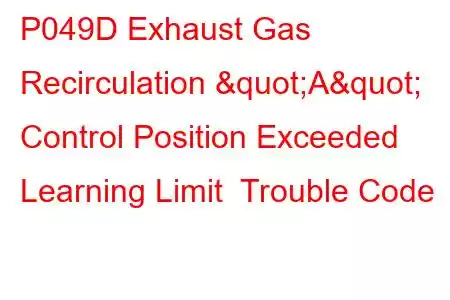P049D EGR A Control Position Exceeded Learning Limit
OBD-II Trouble Code Technical Description
Exhaust Gas Recirculation A Control Position Exceeded Learning Limit
What does that mean?
This is a generic powertrain diagnostic trouble code (DTC) that typically applies to OBD-II vehicles that have an exhaust gas recirculation (EGR) system. That may include but is not limited to vehicles from Dodge / Ram (Cummins), Chevy / GMC (Duramax), Honda, Jeep, Hyundai, etc.
Although generic, the exact repair steps may vary depending on year, make, model and powertrain configuration.
If your OBD-II equipped vehicle has stored a code P049D, it means that the powertrain control module (PCM) has detected a malfunction in a certain control position of the step-down exhaust gas recirculation (EGR) valve. A refers to a specific position of the EGR step-down valve.
The step-down EGR valve system is designed to deliver a portion of spent exhaust gases back to the intake manifold, in measured increments, so that it can be burned a second time. This process is critical in the reduction of nitrous oxide (NOx) particles that are released into the atmosphere as a side effect of internal combustion and diesel engine operation. NOx is suspected of being a contributing factor in ozone depletion from exhaust emissions. NOx emissions are regulated by federal mandate in North American vehicles.
The learning limit is a programmed degree which reflects the minimum and maximum parameters to which a certain position (A) of the step-down EGR valve is able to adapt. If the PCM detects that the actual position of the EGR valve is beyond these parameters, a code P049D will be stored and a malfunction indicator lamp (MIL) may be illuminated. In some vehicle applications, multiple ignition cycles (with a failure) are required for MIL illumination.
What is the severity of this DTC?
Since the code P049D pertains to the EGR system, it should not be considered severe.
What are some of the symptoms of the code?
Symptoms of a P049D trouble code may include:
There will likely be no symptoms associated with this code Slightly diminished fuel efficiency Possible drivability issuesWhat are some of the common causes of the code?
Causes for this P049D EGR code may include:
Defective EGR valve Faulty EGR sensor Bad PCM or a PCM programming errorWhat are some P049D troubleshooting steps?
I would typically begin my diagnosis by locating the vehicle diagnostic connector and retrieving all stored codes and related data. I would write all this information down in case I need it as my diagnosis unfolds. Next, I would test drive the vehicle to see if the code is immediately reset.
By searching vehicle technical service bulletins (TSB) for entries which match the vehicle, codes stored, and symptoms exhibited, you may discover the solution to your (potentially hard fought) diagnosis. Since TSB entries are derived from thousands of repair specialists, they often contain very helpful details.
If the P049D is stored after clearing the codes, I would gain access to a diagnostic scanner, a digital volt/ohmmeter (DVOM), and a reliable vehicle information source.
Now, I would perform a visual inspection of the EGR valve and all related wiring and connectors. Focus on wiring harnesses which are routed near hot exhaust components and the jagged edges often associated with exhaust shields.
NOTE: Disconnect all related controllers from the circuit before testing resistance/continuity with the DVOM.
Using wiring diagrams and connector pin out charts, located in your vehicle information source, test each individual EGR valve connector circuit (with the DVOM) for the appropriate signal. It may be necessary to manually activate the EGR system using the scanner as most systems require a set rate of speed before automatic acti
Read: 45


